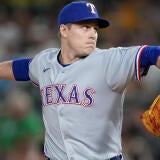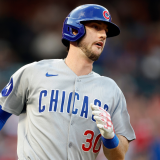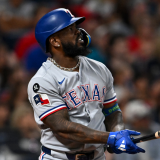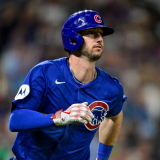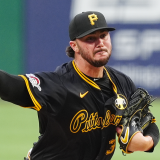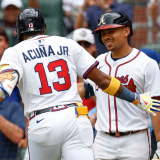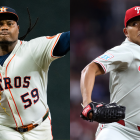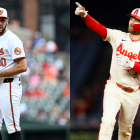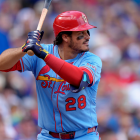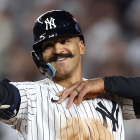MLB playoff breakout candidates: Eight players who could make a name for themselves this postseason
Which underappreciated players could play their way into history this October?
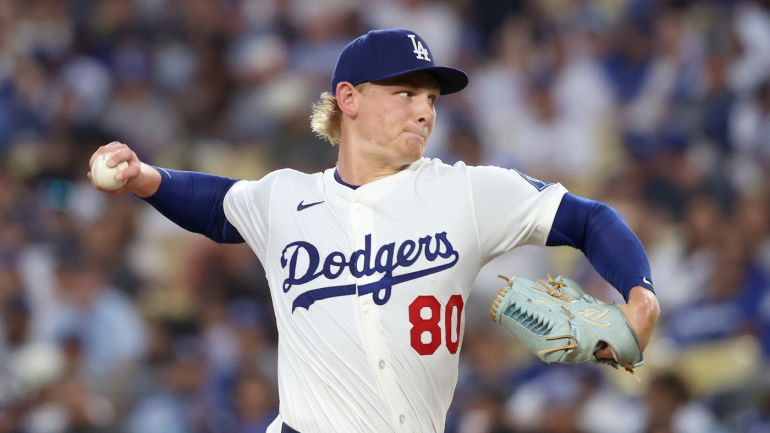
No matter how much changes about Major League Baseball's postseason, one thing remains true: playing well in October is the easiest way to become a household name. Some, like David Freese and Andrew Miller, have used strong playoff runs to transcend ordinary regular-season careers. Others, most recently Randy Arozarena, have used it to introduce themselves to the world.
There's plenty of room for both kinds of breakout stories in any given October. But, for the purposes of this article, I'm focused on the latter: that is, a young or otherwise inexperienced player taking the big stage for themselves. With that in mind, below I've attempted the fool's errand of identifying eight plausible candidates (four per league) who could have a breakout postseason. Do note that the players are presented in alphabetical order, and that I've made a point out of including players from across the popularity spectrum.
With all that fine print out of the way, let's get down to business.
American League
Addison Barger, 3B, Toronto Blue Jays
There are nits to pick with Barger's game. He's streaky, producing as many months with an OPS near .900 as he did with an OPS below .700; he's not a good defensive presence, at third base or elsewhere; and he's weak enough against lefties that Toronto has taken to platooning him with Isiah Kiner-Falefa. Yet I'm including Barger anyway because of his kinetic potential.
Barger has one of the fastest bats in the majors, with more than 60% of his swings registering above 75 mph. Accordingly, he's able to sting the ball often, generating a 91.7 mph average exit velocity and launching more than 50 extra-base hits -- the latter statistic no doubt aided by his tendency to lift and pull. Barger was also solid against each of the pitch type families, hitting at least .240 with six or more home runs against fastballs, breaking balls, and offspeed offerings.
Barger often bats behind Vladimir Guerrero Jr., and I think casual observers might view him as an opportunity for the opposing pitcher to catch their breath. Not so.
Dominic Canzone, RF/DH, Seattle Mariners
Sometimes the third try is, actually, the charm. Canzone couldn't establish a foothold in the majors in either 2023 or 2024 after coming over from the Arizona Diamondbacks in the Paul Sewald trade. He didn't make his big-league season debut this year until mid-June, after Victor Robles injured himself and Leody Taveras proved he wasn't fit to replace him, but Canzone stepped in and stepped up, becoming one of Seattle's most productive hitters in the process.
Canzone is similar to Barger in the sense that he swings hard and makes loud contact, oftentimes to the pull side. He's not as fortified against all pitch types, however, and he's more prone to expanding his strike zone. Defensively, well, there's a reason why the Mariners have deployed Canzone at DH more often as of late, and it's not just out of deference to the since-healed Robles.
Don't let Canzone batting seventh, behind a slew of heavy hitters like Cal Raleigh and Eugenio Suárez, fool you. He too has the kind of thump that can leave the opposition hurting.
Connelly Early, LHP, Boston Red Sox
Early came late, debuting in the majors in September en route to an impressive little stretch of pitching. The Red Sox haven't officially announced their playoff roster just yet, but I figure there has to be a place for him somewhere on the pitching staff.
Early, who looks a bit like a lost Holliday brother, is a lanky southpaw with a six-pitch mix that includes two fastballs, three breaking balls, and a sinking changeup that might be the best offering in his vast collection. So much of modern pitching is tied up in geometry. He has that working in his favor too, thanks to a crossfire delivery, a low arm angle, and a deep release point.
Again, it's to be seen how Early fits into the Red Sox's October plans, but whether it's him or Peyton Tolle, I fully expect at least one of their young southpaws to make an impression.
Cam Schlittler, RHP, New York Yankees
Schlittler has been a boon to the Yankees rotation since debuting in July. In 14 starts, he amassed a 2.96 ERA and a 2.71 strikeout-to-walk ratio while averaging more than five frames per. Sure, he's had a few rough outings, including a September start against Toronto during which he failed to get through the second, but he also turned in seven games in which he allowed one run or fewer.
Schlittler's arsenal is headlined by an explosive upper-90s fastball he relies on more than half the time, but the stars of his show are his breaking balls. He has three distinct pitches that break to the glove side: a low-90s cutter that serves as his top secondary offering, a sweeper, and a spike curveball. Schlittler delivers those pitches from a release point that would've ranked as the fourth tallest in the majors had he qualified, behind only Nick Pivetta, Michael Wacha, and Clay Holmes.
The Yankees' financial might often overshadows their player development chops, but don't sleep on how well they've done to convert Schlittler (originally a seventh-round pick) and Will Warren (eighth rounder) into legitimate big-league starters.
National League
Chase Burns, RHP, Cincinnati Reds
I've been high on Burns since his amateur days, ranking him as the best pitcher available in the 2024 Draft. He's since made a quick ascent to the majors, appearing in 13 games as part of Cincinnati's playoff push. That total includes five consecutive multi-inning relief outings to close out the season.
Burns sure has the stuff to make an impression on a national audience. His pair of fastballs averaged 99.6 mph when he worked out of the bullpen, and he generated a 46.2% whiff rate on his signature slider. As for his overall results, he surrendered two runs on eight hits and three walks while punching out 10 batters in nine innings of work.
I have to imagine the Reds will carry Burns as part of their postseason relief corps. Whether or not Terry Francona is willing to deploy him in meaningful situations is to be seen -- only one of his regular season appearances was in high leverage -- but he'll be appointment viewing regardless.
Caleb Durbin, INF, Milwaukee Brewers
Congratulations to Durbin, acquired from the Yankees as part of the Devin Williams trade, for being the only player who made both this column and my preseason breakouts list. He won't receive a prize, but he ought to receive some downballot consideration for the Rookie of the Year Award after notching nearly three Wins Above Replacement, per Baseball Reference's estimates.
Durbin commands the strike zone and rarely whiffs or strikes out. He ranks near the bottom of the majors in the various exit velocity measures, yet he launched double-digit home runs thanks to his appreciable ability to manipulate his barrel and lift balls to left field. He's an above-average runner, though I must admit I expected better efficiency from him on stolen-base attempts after he succeeded on roughly 85% of his tries in the minor leagues. Maybe next year?
Durbin tends to bat in the bottom half of the order, and I can envision a scenario where he almost single-handedly creates a rally with a hard-earned single and a stolen base. Or maybe he'll just yank a ball over the left-field fence. Either way.
Daniel Palencia, RHP, Chicago Cubs
Palencia came into the season with a career 5.02 ERA in 37 big-league appearances. He didn't record his first save this year until late May, but he's since emerged as a reliable high-leverage weapon for manager Craig Counsell.
It would be fair to describe Palencia as a two-pitch pitcher, fastball or slider, but he prioritizes No. 1 by chucking it more than 70% of the time. That exposure hasn't led to diminishing returns, in part because of his heater's extreme perceived velocity. Palencia's fastball averaged 99.6 mph this season and played even harder thanks to a deep release point that added approximately 0.8 mph. Add in the pitch's innate rising action (he has about an inch more of carry than the average pitcher with a similar release height) and it's no wonder he dominates middle-up in the zone.
It's not as easy for relievers, and especially single-inning closers, to stand out during the postseason. But I think Palencia's pyrotechnics could catch eyes and raise his stock.
Emmet Sheehan, RHP, Los Angeles Dodgers
I had Sheehan as a preseason breakout pick prior to last season, but he hurt his elbow and required Tommy John surgery, wiping out his year. He returned to the majors in mid-June before locking in for good in July, and he's since been a key part of the Dodgers rotation.
Sheehan throws three pitches more than 15% of the time: a mid-90s fastball, a swing-and-miss slider, and a changeup that often sinks. He'll throw a curveball, too, but only on occasion. Sheehan imparts a good amount of rise on his heater for a flat release point. That carry, plus the pitch's velocity, terrorizes hitters up in the zone. It's no wonder the opposition whiffed on more than 26% of their swings against Sheehan's fastball (the league-average swing-and-miss rate on four-seamers was around 22%).
It seems unlikely that Sheehan starts in the playoffs -- the Dodgers have Blake Snell, Yoshinobu Yamamoto, Shohei Ohtani, and Tyler Glasnow at their disposal -- but he ought to have a place on the roster. Maybe he ends up working a few key multi-inning relief appearances.










